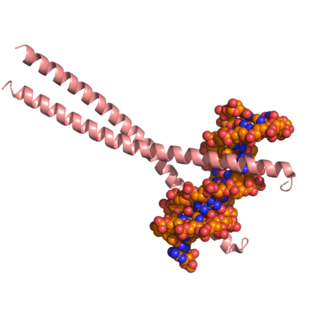CEBPB
Protein-coding gene in humans From Wikipedia, the free encyclopedia
CCAAT/enhancer-binding protein beta is a protein that in humans is encoded by the CEBPB gene.[5][6]
Function
Summarize
Perspective
The protein encoded by this intronless gene is a bZIP transcription factor that can bind as a homodimer to certain DNA regulatory regions. It can also form heterodimers with the related proteins CEBP-alpha, CEBP-delta, and CEBP-gamma. The encoded protein is important in the regulation of genes involved in immune and inflammatory responses and has been shown to bind to the IL-1 response element in the IL-6 gene, as well as to regulatory regions of several acute-phase and cytokine genes. In addition, the encoded protein can bind the promoter and upstream element and stimulate the expression of the collagen type I gene.[7]
CEBP-beta is critical for normal macrophage functioning, an important immune cell sub-type; mice unable to express CEBP-beta have macrophages that cannot differentiate (specialize) and thus are unable to perform all their biological functions—including macrophage-mediated muscle repair.[8] Observational work has shown that expression of CEBP-beta in blood leukocytes is positively associated with muscle strength in humans,[9] emphasizing the importance of the immune system, and particularly macrophages, in the maintenance of muscle function.
Function of CEBPB gene can be effectively examined by siRNA knockdown based on an independent validation.[10]
Upon further investigation, it was noted that CEBPB has close to 8,600 similar correlations with biological manipulations ranging from molecules to proteins or abstracted microRNAs. This protein is found in blood and is upregulated in diseases by acute myeloid leukemia, Glioma, and prostate cancer. This idea is predicated in an intracellular location and precisely localized to the nucleoplasm.
Target genes
CEBPB is capable of increasing the expression of several target genes. Among them, some have specific role in the nervous system such as the preprotachykinin-1 gene, giving rise to substance P and neurokinin A[11] and the choline acetyltransferase responsible for the biosynthesis of the important neurotransmitter acetylcholine.[12] Other targets include genes coding for cytokines such as IL-6,[13] IL-4,[14] IL-5,[15] and TNF-alpha.[16] Genes coding for transporter proteins that confer multidrug resistance to the cells have also been found to be activated by CEBPB. Such genes include ABCC2[17] and ABCB1.[18]
Enhancer Binding-Protein
Summarize
Perspective
The CEBPB gene encodes a transcription factor. As previously mentioned, "It contains a leucine zipper (bZIP) domain and the encoded protein functions as a homodimer. It can also form heterodimers with enhancer-binding proteins such as alpha, delta, and gamma. The activity of this protein is important in regulating genes involving the immune and inflammatory responses, among other processes. The "AUG" start codons, resulting in multiple protein isoforms".[19] It was also mentioned that each of these codon has a different biological function in the body.
This pathway allows for proliferation, inhibition, and even survival. This gene is a vital part of proliferation and segregation. It's important "as the transcription factor regulates the expression of genes that are involved in the immune and inflammatory response, it includes the gluconeogenic pathway and liver recovery. It has a probiotic effect on many cell types, like hepatocytes and adipocytes. However, it exerts differential "effects on T cells by inhibiting MYC expression and promoting differentiation of the T helper lineage." It binds to the regulatory regions of several phase and cytokine genes".[20]
Cancer
CEBPB is a type of CEBP transcript. CEBPB[21] gene is noted in macrophages in SKCM and provides a favorable prognosis with metastatic cancer by being a biomarker for the patient's diagnosis stratification. Through integrated analysis of single-cell and bulk RNA-sequence datasets. Since CEBPB is a transcription factor in regulating gene expression, patients with metastatic melanoma may benefit long-term by blocking proteins such as CTLA-4 Other. Any other pathway of immune activation, such as targeting CEBPB. It is widely expressed in several different cancers.
Interactions
CEBPB has been shown to interact with:
- CREB1,[22]
- CRSP3[23]
- DNA damage-inducible transcript 3,[24][25]
- EP300,[26]
- Estrogen receptor alpha,[27][28]
- Glucocorticoid receptor,[27]
- HMGA1,[29]
- HSF1,[30]
- Nucleolar phosphoprotein p130,[31]
- RELA,[32][33]
- Serum response factor,[34][35]
- SMARCA2,[36]
- Sp1 transcription factor,[29][37]
- TRIM28,[38][39] and
- Zif268.[40]
See also
References
External links
Wikiwand - on
Seamless Wikipedia browsing. On steroids.






